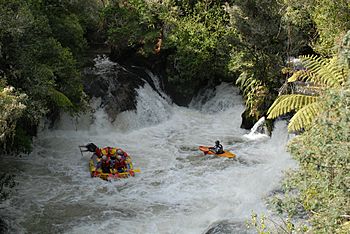Kaituna River facts for kids
Quick facts for kids Kaituna River |
|
|---|---|
 |
|
| Country | New Zealand |
| Physical characteristics | |
| Main source | Lake Rotoiti |
| River mouth | Te Tumu |
| Length | 50 km (31 mi) (approx) |
The Kaituna River is a special river in the Bay of Plenty region of New Zealand. It flows from two lakes, Rotorua and Rotoiti. The river travels north for about 45 kilometers (28 miles). It finally empties into the Bay of Plenty near a place called Te Puke.
The name Kaituna means "eat eels" in the Māori language. This name was given by the New Zealand Ministry for Culture and Heritage. The upper part of the Kaituna River is also known as the Okere River. It is famous for exciting whitewater kayaking and rafting. This area has the world's highest commercially rafted waterfall, which is about 7 meters (23 feet) tall. The river is also a great spot for fishing, especially for trout.
Contents
Protecting the Kaituna River
In the 1970s, Lake Rotorua started to get very polluted. This was due to too many nutrients, like those from sewage. The government's Ministry of Works wanted to send some of this treated sewage into the Kaituna River.
Māori Concerns for the River
However, local iwi (Māori tribes) strongly disagreed with this plan. They believed it would harm the river's mauri. Mauri is a Māori concept meaning the life force or essence of something. They felt that polluting the river would destroy its ability to support plants and animals. It would also be an insult to other iwi and cause them to lose mana (respect or authority).
The Ministry of Works thought the idea of mauri was more about religion than science. They believed diluting the waste in the river would help reduce pollution. They also wanted to keep costs low. But in Māori culture, science and spiritual beliefs are often connected. They are not seen as separate, like they often are in Western cultures.
A Better Solution for the River
In 1990, a new plan was put in place called the Rotorua Land Treatment Scheme. This plan improved how wastewater was treated. It removed 80% of harmful substances like nitrogen and phosphorus. Instead of going into the river, the treated water was used to irrigate land. This helped reduce pollution in the lake and river. It also respected the cultural wishes of the Māori people. This solution was better for the environment, the economy, and the culture of everyone involved.
Power from the River
The Kaituna River has a history with power generation. A small power station operated on the upper river from 1901 to 1936. This was the first power plant built by the New Zealand government.
New Power Station Plans
Over the years, there have been ideas for building a larger power station. However, these projects have always been very expensive. Because of the high costs, none of these larger power stations have been built yet.
In 2008, there was a discussion about building a new hydroelectric power dam. This dam would be below the river at the end of Trout Pool Road. It would create a large man-made dam and flood some land. This would destroy a part of the river known as "Awesome Gorge." Another section, "Gnarly Gorge," would have much less water flowing through it. Many groups, including kayakers, rafters, and local iwi, spoke out against this plan.
Whitewater Adventures
The Kaituna River is famous around the world for its exciting whitewater. People have been rafting and kayaking on the river regularly since 1991. It is used for fun kayaking, guided tandem kayaking, rafting, and even sledging.
A Training Spot for Athletes
During the winter, many paddlers from colder countries come to the Kaituna. The entrance to the upper gorge has a special slalom course. International teams use this course to train for world championships and the Olympic Games. The upper gorge also has fun "play features" for kayakers, like the well-known "bottom hole."
The entire river has been explored by paddlers. The warm water, lush rainforest, and unique character of the river make it a popular spot. You can often see it featured in international whitewater kayak videos.
Famous Waterfalls
There are several notable waterfalls in the upper gorge. These include Okere Falls, Tutea Falls, and Trout Pool Falls. Tutea Falls is the highest waterfall that people can commercially raft down. You can visit all these waterfalls by walking along the Okere Falls track.
Images for kids






